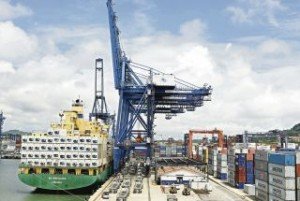
(Newcastle Herald) Panama’s economy notched its second consecutive year of double-digit growth in 2012, driven by a $US5.25 billion expansion of its canal and the development of Central America’s first subway, though a slowdown is expected in 2013.
Panamanian growth reached 10.7 per cent in 2012, the government statistics agency reported on Friday, compared with 10.8 per cent in 2011. Growth in the fourth quarter cooled slightly to a 10 per cent annual expansion rate, from 10.5 per cent in the third quarter.
“We’re very pleased with the economic performance in 2012 and that we are leading economic growth inLatin America despite all the turmoil the global economy is experiencing today,” Finance Minister Frank De Lima told Reuters. “Our perspective for Panama in the medium and long term is very positive.”
The Finance Ministry expects growth to decelerate to about 8.5 per cent this year, although analysts say it is more likely to come in between 7 and 8 per cent, given the strong boost to growth last year from the canal and metro construction.
The tiny Central American country’s economy has largely evaded the global recession, expanding at double-digit rates for four of the past six years.
Much of the growth is credited to significant public infrastructure spending, including the ongoing construction, begun in 2007, of a third lane in Panama’s trademark canal, which will more than double its capacity.
Nevertheless, the canal, which moves about 5 per cent of world trade and makes up 7 per cent ofPanama’s economic output, also felt the pinch from global weakness. Its contribution to the local economy increased just 1.7 per cent in 2012, with transits and cargo dropping slightly.
Logistical and transportation services linked to the canal have grown in importance over the past six years, with port services expanding 5.4 per cent in 2012. The government is expected to begin construction of a third port on the Pacific this year, drawing more investor attention.
“The project of the expansion of the Panama Canal is very important for the country. But Panama is also developing into a hub – its location is very central, you see this in the airline sector,” said Claus Born, senior vice president at investment manager Franklin Templeton’s emerging markets group.
Air travel was up 21.4 per cent in 2012, with Copa Airlines, the national airline, posting a 5 per cent rise in operating revenues in 2012. The airline, which transported 10.1 million passengers last year, offers more daily flights than any Latin American airline, a spokeswoman said.
Overall, public construction projects, including the expansion of the national airport and private development of hotels, offices and apartments, grew by 29.1 per cent in 2012.
Strong government spending translated into a deficit of 2.1 per cent, which some analysts find worrying, given rapid growth.
But Domingo Latorraca, a consultant at Deloitte and former economic vice minister, said if Panamawants to grow into a logistical hub for Latin America, now is the time to bolster its infrastructure.
International companies, including Maersk, the world’s largest container ship operator, continue moving their Latin American headquarters to Panama, drawn by the dollarized economy, connections to South and Central America and Panama’s strong financial sector.
High spending and Panama’s dollarized economy have also fanned inflationary pressures, with consumer price gains hovering around 6 per cent for much of 2012, even though prices declined in recent months.